The flipside of 'animal-friendly'
Corrales' lovely image hides a crisis of dumped animals that falls on a small group of overwhelmed volunteers

“My knees are bloody,” Barbara Bayer says with a wan smile—and the begging metaphor is apt, given that the founder of the rescue group CARMA has given her life blood to helping animals abandoned in the Village. Lately Bayer is perpetually tired, which should come as no surprise considering that her nonprofit has 250 animals awaiting adoption — far more than the 150 on average at the Santa Fe Animal Shelter & Humane Society, the largest rescue operation in the state.
Yet a good many people in Corrales have never heard of CARMA, since it has no office and operates as a network of foster homes and volunteers. The acronym stands for Companion Animal Rescue and Medical Assistance—a name that popped into Bayer’s mind in 1999 “almost like it was meant to be,” she says without irony—but which suits an operation that seemed to grow from sheer fate.
Bayer and her husband, Bill Woldman, moved to New Mexico from New Jersey two decades ago. She had always been an animal-lover with a special fondness for cats. When she fetched one of her animals boarding at Corrales Kennel around 14 years ago, she learned that stray dogs were also housed there, and started wondering why.
“In those days Corrales Animal Control had a contract with Albuquerque to euthanize,” she says. Strays would be kept at the private kennel only a few days before being shipped to Albuquerque, which received payment for each kill. In other words, Corrales Animal Services basically consisted of a dog catcher and a pound. People scoffed at the very notion of “no-kill,” she says.
SOCIETAL ATTITUDES about animals have flipped since then, and if Corrales is a state leader in the no-kill movement, the Village has Bayer to thank. As she took on more and more strays to prevent them from being executed, she found herself needing a fundraising organization just to keep pace.
“I wasn’t doing it because I wanted the animals. I just didn’t want them to be killed,” she says. “I told Animal Control, I will take any animal. And I had to fight for every one.” Suspicion greeted her mission to “save lives,” and has continued to haunt her campaigns to raise money for expensive surgery, cover airlifts to animal sanctuaries, ship adoptables cross-country to where they have a better chance at finding homes—all in the name of no-kill.
When she disagreed with other board members on whether to invest in saving an animal, the animal ultimately came first. “That was how we got into this—one animal at a time. We came to the conclusion that we had to do everything for that animal, to make him fit to be adoptable. And that is really the goal—to save lives, to get them safe, healthy, and fit to be in people’s homes.”
Bayer has been called a hoarder, a nut, “I have been called everything,” she sighs. But two years ago the Village Council of its own accord voted to codify the rule that no stray animals here would be euthanized for lack of space.
“I was delighted,” Bayer says. Yet it had proved politically easy to do only because CARMA had already made the Village no-kill for at least a decade. Thanks to a cooperative relationship with Corrales Animal Services, CARMA has taken responsibility for sheltering and placing every animal abandoned in the Village, more than 4,500 of them in the last decade.
The new law raises the stakes, however, in that the Village is now legally bound to care for strays—even though it has no facility to do so. The dog runs it leases at Corrales Kennel are usually full, and CARMA has run out of resources. Its half dozen foster homes are beyond full, volunteers having given over garages and outbuildings to the overflow. Adoption happens at a trickle, since the only regular venue is at Petco on Saturdays.
THE RISK INHERENT in the situation became clear a year ago, when Animal Services got hit with a crisis. An elderly resident who lived alone was institutionalized, and her 24 animals had to be taken into protective custody: 19 cats, five dogs, and an alpaca.
“That put us over the edge,” says Bayer, who retired last year from her position as deputy manager of senior services for Rio Rancho to look after the scores of animals in her care. “It made it clear that we can’t continue to function without a vehicle for them to be seen.”
Bayer has grown hoarse appearing before the Village Council to plead for a municipal animal shelter. Most CARMA volunteers are in their 60s and 70s, she notes. And while she applauds the current Council’s commitment to animal causes, the people of Corrales need to act, she says, and exercise their political muscle. “It’s not only what you can do as an individual to volunteer or foster, but also what you can do politically, as far as letting the Council and mayor and candidates know how supportive you are of animals in this community.”
The “out of sight, out of mind” problem of animals dumped in Corrales—which pre-dates no-kill— also has cloaked the Village dilemma. While CARMA is constantly overrun with adoptable animals, Animal Humane was moving 50 pets a month from its storefront adoption center at the entrance to the Village (which it closed last year.) CARMA has always managed to struggle through when it gets hit with an extraordinary case. “We beg if we need to, like everyone else,” Bayer says. “But it’s figuring out how to tell our own story.”
BAYER AND OTHER animal-lovers in the Village decided to act in 2004, establishing FOCAS, Friends of a Corrales Animal Shelter, to pursue the idea of building a shelter. Two years later, the effort stalled for lack of progress.
Hope re-emerged in December with the discovery that Corrales could take advantage of a legal loophole to preserve sales tax revenue by issuing municipal bonds. Bayer and other CARMA members appeared repeatedly before the Village Council to press for an animal shelter, noting that Corrales is the only no-kill community in the nation without one.
The Council, distracted by a looming financial crisis brought on by a hexed sewer installation, appointed a task force to study the issue. The group is to report back by September on its recommendations. Bayer was not among those appointed to the group, for which she expresses no rancor.
“It is truly not just about CARMA,” she says. “We need a focal point for this community to live out what they say they are about, which is to be animal-friendly. It’s not just about a building.”
Bayer hopes the Village can acquire land to build a facility that taps the many resources available on how to build an effective adoption center, such as was done by Animal Humane last year. She suggests starting with housing for 50 cats and 20 dogs in a cage-less setup known as congregate housing. “There are organizations that have expertise in how to direct development in a cost-effective way,” she says.
Without a plan in place, however, the community has no way to visualize its role. “If you don’t know where you’re going, you don’t know how to get there. The vision has to be there,” she says— and she’s living proof.
With a new mayor and Council being seated this year, it’s crucial that animal-lovers inside and outside Corrales speak up to protect the animals of the Village, Bayer says. “It’s a call to action on all levels.”
